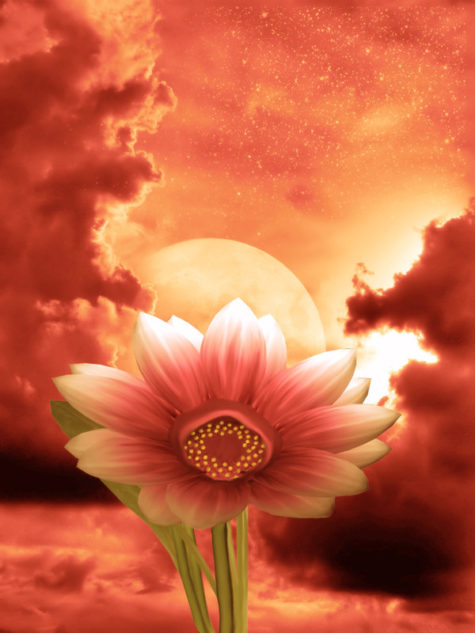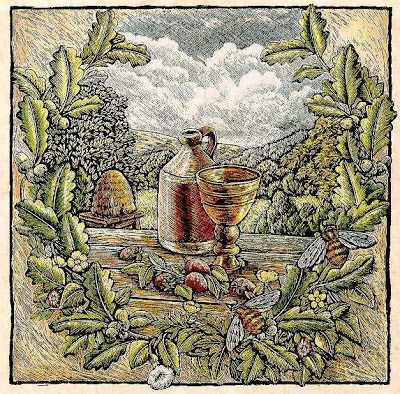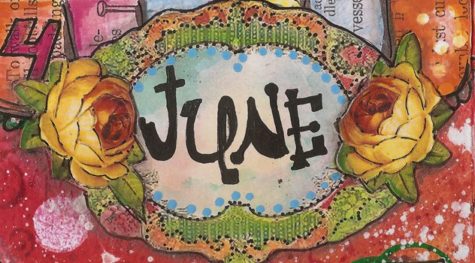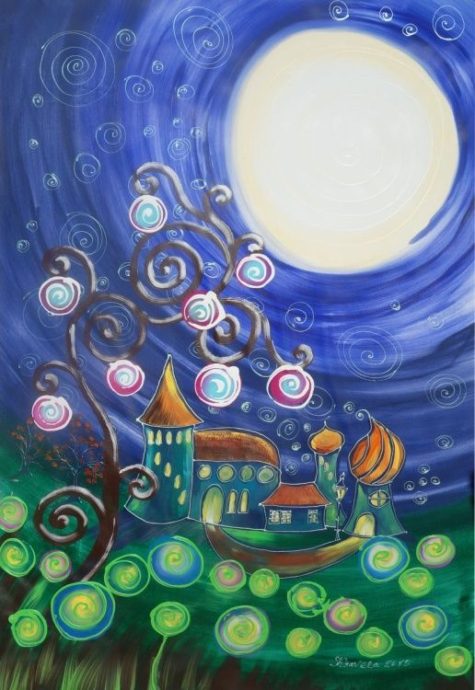Folklore
August, originally called Sextilis by the Romans, was later named Augustus in honor of Augustus Caesar. Gathered harvests were celebrated in many lands during this month.
August 1st was a Celtic feast called Lunasa or Lughnassadh, meaning the celebration of harvest and new grain for bread. In Old English this became Lammas, or “Loaf Mass.” The Romans also had a harvest festival during this month, that of the Consualia when sacrifices to Consus were made. Consus was the god of the underground storehouse where the grain was kept.
They also celebrated the Opseconsiva, a harvest festival for the goddess Ops. Wine and freshly baked bread were placed on her altars. Near the end of the month they had a thanksgiving feast called the Charisteria.
At three times during August, the Romans honored the god Vulcan: on August 17 at the Portunalia; on August 27 at the Volturnalia; and again on August 23 at the Volcanalia. this last festival was held outside the city boundaries and was to ward off accidental fires, a real threat in such closely-packed and fire-prone towns. Vulcan was not the only deity honored during these festivals. The goddesses Juturna (deity of fountains) and Stata Mater (who put out fires) were invoked as a counterbalance to Vulcan’s fires – volcanoes or otherwise.
The very early Greeks had a holy day for Hecate the Dark Mother on August 13, and ten days later one for Nemesis, the goddess who balanced the scales of justice with rightful revenge and punishment. In Rome, women who had prayers answered by Diana and Hecate marched by torchlight to the temples of these goddesses. There they held a special ceremony for women only and gave thanks.
The Egyptian Blessing of the Boats is quite similar in nature to the Roman festival of the Ludi Piscatari in June during the Mead Moon. Each boat was considered to have its own personality and a need for protection and blessing. The same can apply today to cars, boats, bikes, motorcycles, and in fact to any form of transportation upon which one relies.
In India today, the Hindu people still honor the elephant-headed god Ganesha, the deity who removes obstacles and brings good luck. Flowers and dishes of rice were set before his statues. However, it is considered unlucky to look at the Moon during this festival.
Yapaquix (Sowing Month), also known as Chacra Ayapui or Capac Siquis, was celebrated by the Incas. The people of Tibet had only one major holiday this month, the Sikhim festival of the birth of Padmasambhava.
From: Moon Magick
July 10th is Lady Godiva Day. I’m sure we’re all familiar with the story – but here it is again:
The Countess Godiva devoutly anxious to free the city of Coventry from a grievous and base thralldom often besought the Count, her husband, that he would for love of the Holy Trinity and the sacred Mother of God liberate it from such servitude. But he rebuked her for vainly demanding a thing so injurious to himself and forbade her to move further therin.
Yet she, out of her womanly pertinacity, continued to press the matter insomuch that she obtained this answer from him: “Ascend,” he said, “thy horse naked and pass thus through the city from one end to the other in sight of the people and on thy return thou shalt obtain thy request.”
Upon which she returned: “And should I be willing to do this, wilt thou give me leave?”
“I will,” he responded.
Then the Countess Godiva, beloved of God, ascended her horse, naked, loosing her long hair which clothed her entire body except her snow white legs, and having performed the journey, seen by none, returned with joy to her husband who, regarding it as a miracle, thereupon granted Coventry a Charter, confirming it with his seal.
From the Flores Historiarum by Roger of Wendover
Because the warm weather continues, activity levels are high, even though the days are beginning to shorten. Consequently, numerous festivals during this month focus on family, friends, and social interaction.
For magical purposes, July directs our attention to personal growth and improvements. This includes increasing your knowledge, continuing efforts for prosperity, creating new ideas and works of art, and also taking time out periodically to really enjoy yourself. Our society sometimes mistakes much-needed leisure time for laziness but this months’s energies know better. Go and have fun, carrying the Goddess with you for a little extra energy.
July Correspondences:
- Nature Spirits: hobgoblins (small grotesque but friendly brownie-type creatures), faeries of harvested crops.
- Herbs: honeysuckle, agrimony, lemon balm, hyssop
- Colors: silver, blue-gray
- Flowers: lotus, water lily, jasmine
- Scents: orris, frankincense
- Stones: pearl, moonstone, white agate
- Trees: oak, acacia ash
- Animals: crab, turtle, dolphin, whale
- Birds: starling, ibis, swallow
- Deities: Khepera, Athene, Juno, Hel, Holda, Cerridwen, Nephtys, Venus
Power flow:
Relaxed energy; preparing, succeeding. Dream work; divination and meditation on goals and plans, especially spiritual ones.
July Festivities:
At first the Romans called this month Quintilis, but later renamed it Julius after Julius Caesar, who was born in this summer month. The Greek Olympian was held for about a week in July. This festival in honor of Zeus consisted of competitions in athletics, drama, music, and other activities. During the time of the Olympian, all participants were given safe-conduct to and from the games. The constant petty Greek squabbles were put aside. A victory in the Olympian was a great achievement, both for the individual and for their city.
Two of the Roman holidays held during this month were July 8 – 9 when the Goddess Juno was honored and the Neptunalia on July 23, when Neptune, the god of the seas and earthquakes, was placated.
In Japan, the Full Moon of July saw the O-Bon, or Festival of Lanterns. This was a combination of Buddhist and Shinto beliefs that honored the dead. Homes, tombs, and ancestral tablets were thoroughly cleaned. Altars and shrines were decorated. The gardens were hung with lanterns to light the way of the dead so that they could join with their families for the three-day ceremony.
The Egyptian New Year fell in July, as did the Opet Festival, which commemorated the marriage of Isis and Osiris. Their sexual union was said to bring good luck to all people. About the same time in Rome, the love of Venus and Adonis was celebrated. The Egyptian year was measured against the Nile and its yearly fertile floods. This was also the time of the birth of Isis and Nephthys, Osiris, Set, and Haroeris. These days were the ones won by Thoth for these deities; births; in other words, there were the necessary days to make the solar and lunar calendars match.
The Incas had a ceremony called Chahua-huarquiz, Chacra Ricuichi, or Chacra Cona, which meant Plowing Month. While the Northern Hemisphere was beginning its agricultural harvests with the reaping of the corn crop, the Southern Hemisphere was just beginning to break ground for planting.
Buddha’s Birth and Preaching, also called the Picture Feast, was celebrated in Tibet.
From: Moon Magic and 365 Goddess
What follows is a list (in alphabetical order) of the names given to the July moon. Also listed is the tradition and/or origin of that moon name:
Blackberry Moon ~other
Little Ripening Moon ~Creek
Blessing Moon ~Dark Janic
Blood Moon ~other
Buck Moon ~Algonquin
Buffalo Bellow Moon ~Omaha, Arapaho
Claiming Moon ~Celtic, Janic (full)
Corn Popping Moon ~Winnebago
Crane Moon ~Choctaw
Dropping Deer Horns Moon ~Kiowa
Ducks Moult Moon ~Cree
Fallow Moon ~other
Grain Moon ~other
Grass Cutter Moon ~Abernaki
Hay Moon ~Cherokee, Algonquin
Horse Moon ~Apache
Hungry Ghost Moon ~Chinese
Little Harvest Moon ~Creek
Little Ripening Moon ~Creek
Mead Moon ~Medieval English
Meadow Moon ~other
Middle Summer Moon ~Ponca, Dakota
Peaches Moon ~Natchez
Raptor Moon ~Hopi
Raspberry Moon ~Anishnaabe
Red Berries moon ~Assiniboine
Ripe Corn Moon ~Cherokee
Ripe Moon ~San Juan, Apache
Ripe Squash Moon ~Agonquin
Ripening Moon ~Mohawk, Passamaquoddy
Rose Moon ~Neo Pagan
Salmon River Moon ~Wishram
Smoky Moon ~Maidu
Summer Moon ~Colonial American, Algonquin
Sun House Moon ~Taos Native American
Thunder Moon ~Algonquin
Wild Red Cherries Moon ~Sioux
Wort Moon ~other
Young Corn Moon ~Potawatomi
What follows is a list (in alphabetical order) of the names given to the June moon. Also listed is the tradition and/or origin of that moon name:
- Aerra Litha Moon ~other
- Blackberry Moon ~Greek
- Buffalo Moon ~Omaha
- Corn Tassel Moon ~Taos
- Dark Green Leaves Moon ~Pueblo
- Dyad Moon ~Medieval English
- Fish Spoils Moon ~Wishram
- Flower Moon ~Cherokee
- Green Corn Moon ~Cherokee
- Green Grass Moon ~Sioux
- Hay Moon ~other
- Hoer Moon ~Abernaki
- Horses’ Moon ~Celtic
- Honey Moon ~Algonquin
- Hot Moon ~Algonquin
- Hot Weather Moon ~Ponca, Arapaho
- Leaf Moon ~Assiniboine
- Leaf Dark Moon ~San Juan
- Leaves Moon ~Cree
- Lotus Moon ~Chinese
- Lovers’ Moon ~other
- Major Planting Moon ~Hopi
- Making Fat Moon ~Lakota
- Mead Moon ~Janic (full)
- Planting Moon ~Neo Pagan
- Ripe Berries ~Dakota
- Ripening Moon ~Mohawk
- Rose Moon ~Algonquin
- Strawberry Moon ~Anishnaabe, Dark Janic, Algonquin
- Strong Sun Moon ~other
- Summer Moon ~Kiowa, Passamaquoddy
- Turtle Moon ~Potawatomi
- Water Melon Moon ~Natchez
- Windy Moon ~Choctaw
The original Roman name for this month was Junoius, after the Great Mother Goddess Juno; her counterpart among the Greeks was Hera. The Summer Solstice has been and still is important to many religions and cultures around the world. Not only was it sacred to goddesses of fertility, marriage, and love, but it was considered to be a time when faeries, elves, and many other supernatural beings were abroad in great numbers.
June’s energies are focused on socialization and activity. It is a capricious month, filled with young love, romance, and the companionship of good friends. Any magic aimed at enhancing one’s relationships, communication skills, and the personal energy level necessary for maintaining both will be augmented by working during this month.
The magickal correspondences for June can be found at Magickal Ingredients, here: Correspondences for June.
The June Moon has enormous energies for calling upon and working with elementals of all types. Tides of psychic energy flow freely, enabling even the most staid of people to experience unusual happenings.
On or about 21 June is the Summer Solstice, the festival of Midsummer, the Anglo-Saxon Lith and the Alaban Hefin of the Druids. The Irish name for June is Meitheamh, while the Anglo-Saxon name was Aerra Litha, “before Litha.” The Franks called June Brachmanoth, “break month,” while in modern Asatru it is called Fallow.
The Summer Solstice festival in Slavonic-Russian cultures was called Kupalo and Jarilo. Other names were Kostroma, Sobotka, Kresnice, and Vajano. Kupalo/Kupala was the name of an ancient Slavic deity, originally a goddess, later a god. Special features of this festival were the lighting of fires, the sprinkling of water, and foretelling the future.
The Full Moon festival of Edfu in Egypt honored the goddess Hathor. The cow horns on her head represented the Crescent Moon. Every year at the new Moon the stature of Hathor was taken from her temple at Dendera and transported by boat to the temple of the god Horus at Edfu, arriving on the Full Moon.l This festival celebrated the frank sexual union of the two deities. It was a time of great festivities and very likely human marriages, since it was considered a period of good luck.
The Egyptian festival called the Burning of the Lamps took place in Sais in the temple of Isis. There, in an underground chapel beneath the main temple, was a wooden coffin for the god Osiris. Priestesses, priests, and initiates gathered in this hidden place carrying lamps. Then they marched in a procession around the coffin. The Egyptians said it was the light of the Moon that Isis called upon to bring Osiris back to life. Myth says that when Osiris ascended to the heavens, he went to the Moon.
In Rome, the month of June was sacred to the goddess Juno and therefore a lucky month in which to be married. It was also a time for the Vestal Virgins to cleanse the penus (a sacred vessel) in the Temple of Vesta.
The Roman celebration of the Ludi Piscatari, or festival of the fishermen, was really a blessing of boats. They believed that every boat had a personal spiritual entity. If the powers that went into the boat during its building were not in harmony with the entity, the boat would never ride easily on the water; it would always fight with the wind and the waves. The ritual of blessing the boat harmonized the energies imbued in the vessel, making it lively, willing, and enduring.
The Celtic Day of Cerridwen and her cauldron may have originally been associated with the Summer Solstice. Cerridwen of Wales was a Dark Moon goddess; her symbols were the cauldron, grain, and the Moon. The white, corpse-eating sow, representing the Moon, was one of her animal emblems.
In Tibet, this was a time of masked sacred dances and mystery plays. They had celebrations of the Medical Buddhas and of the Birth of Padmasambhava, who was considered to be a great spiritual teacher.
To the Incas in the Southern Hemisphere, this was the season of the Winter Solstice, since seasons are reversed. They had the Feast of the Sun, or the Inti Raymi, to celebrate the maize harvest. Chanting would last from sunrise to sunset. Inti was the Sun god of the ruling dynasty, represented by a great golden disk with a human face.
As ruler of the high point of the year, the time of the maximum light and minimum darkness, June is the light counterpart of Janus, the ruler of the New Year period. In the Goddess Calendar, the first 12 days of June belong to Hera. On 13 June begins the month of Rosea.
The month of June is the “door of the year,” the gateway to the inner realms. The rune Dag that rules the middle of the month, is the rune of opening, representing the door that excludes bad things and admits only that which is beneficial. The runic year begins in June, with Feoh.
The Celtic Tree Calendar month of Huath (hawthorn) ends on 9 June to be followed on the 10th by the Oak month, Duir. This is a month of strengthening and consolidation of gains. It can also be said to represent the “door” of the year, opening to let the sun shine in. Duir had the sacred color of black.
From: Moon Magick and other sources
“What is one to say about June, the time of perfect young summer, the fulfillment of the promise of the earlier months, and with as yet no sign to remind one that its fresh young beauty will ever fade.” ~Gertrude Jekyl
June takes its name from Juno, the Roman goddess of the hearth and home, and patron wives.. Not surprisingly, June became the traditional month for marriage in Rome, and it continues to enjoy tremendous popularity for weddings today.
Married in the month of roses – June.
Life will be one long honeymoon.
In medieval times June was chosen for the month to marry because the annual baths of the populace took place in May. From May to the following May cleanliness was not a part of their daily ritual as it is today. It was an annual event. So, being that they were relatively clean in June made it a good time to have a special event such as a wedding.
June is also the favored month for flower festivals, likely due to the abundance of earth’s blossoms around this time of year. Other associations include the following:
- Flower: Rose and Honeysuckle
- Meaning: Health and longevity
- Gemstone: Pearl, Moonstone, and Alexandrite
Another precious stone associated with June is the agate, whose traditional rhyme is as follows:
Who comes with summer to this earth,
And owes to June her hour of birth
With ring of Agate on her hand
Can health, wealth and long life command.
June is named after the Roman Great Mother Goddess, Juno; the Greek Hera. The month’s name was originally Junonius. Juno has may attributes, the chief of which is as the Queen of Heaven. This is attribute is ascribed to Frigg in the Northern Tradition and Mary in the Christian.
June has been considered a lucky month since Roman times. As Juno Moneta, guardian of money and wealth, the goddess had a temple dedicated to her on the Capitoline hill in Rome. This contained the mint where coinage was produced. This theme of wealth can also be seen in the runic year cycle: the half-month of Feoh, the time of wealth and abundance, begins on 29 June.
 A man who married in June was guaranteed prosperity, and his wife happiness. This was because the Goddess Juno was associated with money and wealth, and also because she was happily married to Jupiter.
A man who married in June was guaranteed prosperity, and his wife happiness. This was because the Goddess Juno was associated with money and wealth, and also because she was happily married to Jupiter.
Whenever anyone got married in her month, Juno ensured the union was blessed with great happiness. June also has the longest day of the year, and this symbolizes a long and happy marriage.
June’s full moon is sometimes called the Hot or Strawberry Moon.
The May full moon is also known as the Flower Moon, Milk Moon, Corn Planting Moon, and Corn Moon. The energies around this moon are ones of health, romance, love and wisdom. We are encouraged to begin to take action on the things we’ve recently been planning.
Once April’s rains and winds have subsided, the sun begins to warm up the earth and we’re able to get the gardens planted. Thus May is the month we begin to sow our crops. Get out in the garden under a Flower Moon and put your hands into the soil. May’s Moon brings us energy of love, wisdom and health. Spring is a time of fertility, and May is a fiery month indeed — full of lust and passion! It’s called the month of the Hare’s Moon — and we all know what hares are busy doing in the spring.
Correspondences:
- Colors: Red, orange, yellow
- Gemstones: Ruby, garnet, amber, Apache tear
- Trees: Hawthorn, rowan
- Gods: Kali, Priapus, Cernunnos, Flora
- Herbs: Cinnamon, members of the mint family
- Element: Fire
Gems and oils to boost the energy of the Hare’s Moon
- Gemstones: Malachite, Jade, Emerald, Peridot or any other green-hued stones.
These gems help enhance the energy of the heart chakra, which governs our compassion, generosity, love and harmony. If you need a boost in any of these areas, simply slip a green stone into your pocket, or put on a piece of green-gemmed jewelry.
- Essential Oils: Eucalyptus, Thyme, Sandalwood, Pine, Melissa, Bergamont.
These oils will help you connect with your unconscious mind and set the intention of love, wisdom and compassion
Celebrating The May Full Moon
The May full moon is a time when we begin to really notice more light in our lives. The days are longer, the grass is green and the flowers are starting to bloom. The energy at this time is playful and light, energetic and buoyant. If you want to really celebrate this moon and the energy it brings, you can do fun things like:
- host a pot-luck with a spring theme
- visit your local elementary school and volunteer during art class
- light a green candle and meditate on your thankfulness for the feeling of renewal and rejuvenation.
Other ideas:
Another great way to connect with the Hare’s Moon is to bless some seeds, seedlings or garden plants, and then plant them. Doing this involves intentionally adding positive energy to these plants, and then nurturing their growth and health. This is a powerful symbolic exercise that will help you focus your energy on intentionally giving “good vibes” to your environment. Doing this will make you feel empowered, positive and loving.
This is also a good time to work on magic related to careers and jobs. Thinking about switching to a new position, or perhaps trying a new field altogether? Want to take a class or get your degree? Take the seeds you’ve planted last month, and allow them to bloom and grow in your favor. Do some fire divination this month to help guide you on your way.
source: PaganWiccan
For the purpose of your magical escapades, the theme is definitely blossoming and liveliness. Use as many flower parts as possible in spells and rituals, and go outside frequently to get closer to nature. Energies emphasized by this month include creativity, inventiveness, fertility, health, and metaphysically “spring cleaning” any area of your life or sacred space.
Bring me my drum and bring me my cymbal,
Bring forth the sustrum, bring forth the timbal.
Dance now for Hathor, celebrate beauty,
dance in Her honor, sing for our lady.
May gets its name from the Roman goddess Maia, who embodies the earth’s renewal during spring. Next to New Year’s Eve, May Day was among the most popular holidays in the old world, marking the time when the sun’s warmth and nature’s fertility began appearing in the land. Later, well over one hundred nations chose to celebrate Labor Day on May 1, giving everyone a much-needed rest from winter’s tasks.
The Greek goddess Maia, the most important of the Seven Sisters (the Pleiades) and said to be the mother of Hermes, gave the name to this month. Some form of this goddess’s name was known to people from Ireland to as far away as India. The Romans called her Maius, goddess of Summer and honored her at the Ambarvalia, a family festival for purification and protection of farm land.
In the Celtic cultures, May was called Mai or Maj, a month of sexual freedom. Green was worn during this month to honor the Earth Mother. May 1 was the Celtic festival of Beltane, a festival celebrating fertility of all things. Cattle were drivien through the Beltane bonfires for purification and fertility. In Wales, Creiddylad was connected with this festival and often called the May Queen. The maypole and its dance is a remnant of these old festivities.
The Sheila Na Gig is still seen carved in the decorations of many Irish churches. This goddess figure is a grotesque, often emaciated, woman shown squatting and holding wide her private parts. Many Irish still know her as the protector of the poor and hang old clothes on hawthorn bushes on May 4th. This is believed to avert poverty. It is possible that the Australian term “Sheila,” used as a name for any woman, refers to this ancient deity and her carvings.
Bona Dea, the Roman Good Goddess, had her festival on the night between may 2nd and 3rd. No men were allowed to attend.
The Roman festival of Lemuria was to placate and remember the Lemures, or the wandering spirits of the dead. Each family performed its own private ceremonies, which ended with taking gifts to the graves. For those who had died and had no graves, the head of the household walked barefoot through the house, casting nine black beans behind him.
The Greeks had a special festival for the god Pan during May. Pan was a wild looking deity, half man, half goat. As a token of his frequent sexual adventures, he was shown with an erect penis. Pan invented the syrinx, or pan-pipes, made out of reeds. Originally, he was not an oppressor of women, but their loving companion.
May 19-28 was the solemn Greek festival called Kallyntaria and Plynteria. This was devoted to the cleaning and freshening of sacred statures and temples. The statues, small enough to be moved, were taken to a nearby river or lake and washed until clean. This was serious business with no singing or merry-making.
At the end of the month was a Roman celebration honoring the Underworld Queen Prosperina and her consort Pluto. Proserpina ruled over the resting place of the shades (souls), but her kingdom was connected with more than death. Pluto was also known as the deity of hidden wealth.
In Finland, May 1 was celebrated as Rowan Witch Day, a time of honoring the goddess Rauni, who was associated with the mountain ash or rowan. Twigs and branches of the rowan were, and still are, used as protection against evil in this part of the world. Some sources list Rauni as a god.
The Slavonic-Russian cultures had a similar, but longer, festival celebrating merriment, rivers, and well-being. This occured between May 25 and June 25. Originally it honored the goddess Lada, who later was changed to the god Lado.
Mugwort was a sacred herb in China and Europe. As part of the celebration on May 5, the Chinese made dolls out of the leaves. They hung these dolls above gates and doors to repel negative influences and entities.
In Tibet, an old Nature festival for the beginning of Summer and the rain deities became a celebration of Buddha’s death and his attainment of Buddha-hood. The attainment festival occurred on May 8, while celebration of Buddha’s death was on May 15. Deceased relatives were prayed for at this time.
The Incas held Aymoray Quilla or Hatun Cazqui, which was the Great Cultivation.
From: Moon Magick
What follows is a list (in alphabetical order) of the names given to the May moon. Also listed is the tradition and/or origin of that moon name:
Alewive Moon ~Passamaquoddy
Big Leaf Moon ~Mohawk
Blossom Moon ~Anishnaabe
Bright Moon ~Celtic
Corn Planting Moon ~Taos, Algonquin
Corn Weed Moon ~Agonquin
Dyad Moon ~other
Fat Horses Moon ~Cheyenne
Field Maker Moon ~Abernaki
Flower Moon ~other
Frog Moon ~Cree
Frogs Return Moon ~other
Grass Moon ~Neo Pagan
Green Leaf Moon ~Apache
Green Leaves Moon ~Dakota
Hare Moon ~Medieval English
Hoeing Corn Moon ~Winnebago
Idle Moon ~Assiniboine
Joy Moon ~other
Leaf Tender Moon ~San Juan
Little Corn Moon ~Natchez
Merry Moon ~other
Milk Moon ~Colonial American, Algonquin
Mothers Moon ~Janic (full)
Mulberry Moon ~Greek
Ninth Moon ~Wishram, Janic (dark)
Panther Moon ~Choctaw
Planting Moon ~Cherokee
Ponies Shed Moon ~Sioux
Shaggy Hair Moon ~Arapaho
Sproutkale Moon ~other
Strawberry Moon ~Potawatomi
Waiting Moon ~Hopi













